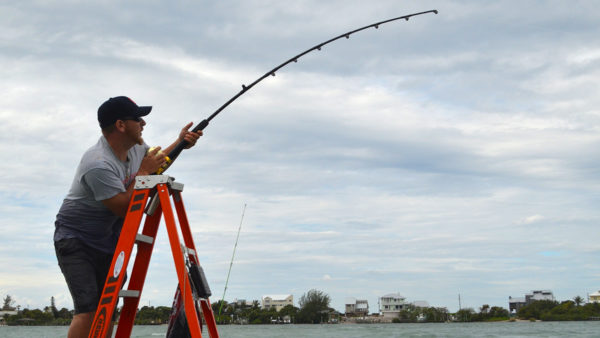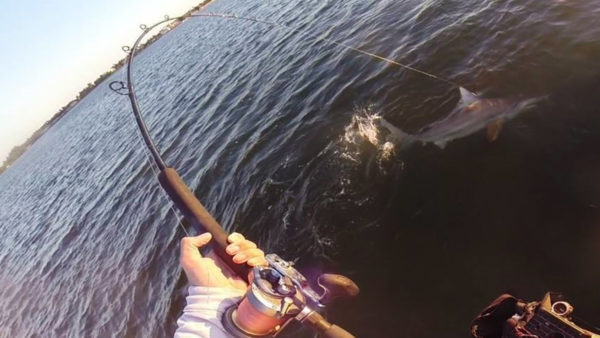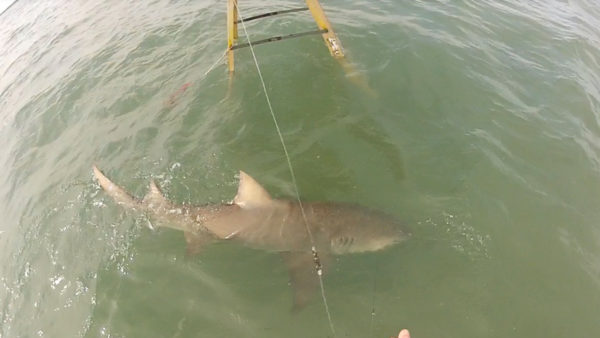
Hogs. Toads. Donkeys. Pigs. Whatever name you prefer, these are the fish you really want to catch. Quantity fills the freezer, but trophies earn the bragging rights. This series is dedicated to the pursuit of the true heavyweights across all species. The meat eaters. So question your sanity and love of the extreme as we explore the protocol for standing on a ladder to battle a shark.
If you’re reading this, then you’re finally stepping up (pun intended) to the newest heights of saltwater fishing. Since pioneers (such as myself) first started ladder fishing for sharks on the flats of South Florida roughly six years ago, fishermen have been clamoring for information on how to elevate (get it?) their shark angling abilities. My phone just won’t stop ringing.
Fishing from a ladder has advantages, which cutthroat trout anglers at places like Pyramid Lake in Nevada figured out many years ago. Being elevated gave those fluff chuckers a clearer picture of their surroundings, and also allowed them to post up close to and cast over drop-offs without having to stand chest deep in the water. Ladders can similarly benefit the shark game, but the consequences of screwing up are more severe. The world’s biggest trout can’t do half the damage of the world’s smallest shark. But fear not. Provided you modify your battle station properly, you’ll have a stable fighting platform that gives you plenty of leverage while keeping your lower extremities away from the business end of your target.

All shark fishing—regardless of where and how you do it—comes with some element of danger. It’s a sport in which common sense should always prevail (though it doesn’t always; just look at YouTube). So you don’t end up in a viral video for all the wrong reasons, here are some guidelines to help you feed your newest fishing addiction responsibly.
The Ladder
Many people ask, “Hey Zach, who makes the perfect sharkin’ ladder?” Werner brand, without question. Werner is the most trusted ladder among blue collar trade workers across America for its top shelf construction, unparalleled safety, and reliability. Any other ladder, throw it directly in the trash, because if you set up on the flat with that antique you use to clean the gutters, you may lose some digits or possibly a limb. At present, Werner does not have a fishing pro staff, but I’d be the first one on it.
Since you’re in a salty environment, fiberglass frames are ideal. Metal ladders will work, though you’ll have some corrosion issues if you don’t clean them thoroughly. Skip wooden ladders altogether.
I find an 8-foot A-frame perfect for sharking. Any shorter and you risk having too much of your body in the water; if you go taller, the ladder can become too top heavy and susceptible to tipping during a fight or even if the tide is running strong. It’s also worth noting that, whether you’re walking your ladder onto the flat or using a spare kayak to tow it out like I do, ladders longer than eight feet get cumbersome and awkward to transport.
The Modifications
To further increase the stability of my ladder, I attach 3-foot pieces of pressure-treated 1×4 horizontally across the feet. The boards create greater surface area and add stability on soft bottoms, much like snowshoes on snow. I highly recommend mounting a rod holder on the top or side of the ladder. I like a 25-degree stainless steel rod holder, the kind you’d find on the gunwale of a boat, but I’ve duct-taped on pieces of PVC in a pinch and they worked just fine. Finally, I clip a large carabiner to the front support brace. It’s perfect for hanging a tackle bag or small, soft-side cooler full of drinks, bait, and snacks in an easy-to-reach place where it won’t get wet.

The Bait & Tackle
The ideal bait and tackle for ladder shark fishing will certainly vary by location and species, but as a general rule, you want a conventional reel that holds at least 300 yards of line and has a gear ratio of 5:1 or higher. This is important, because when a shark comes screaming right at you, being able to pick up slack line fast helps you avoid the fish getting tangled in the ladder.
I understand that braid is all the rage these days, but I prefer to spool up with 50-pound monofilament. Mono is forgiving and has stretch; braid has no stretch, which could actually lead to you getting pulled off the ladder during a fight. I add a 6-foot top shot of 100-pound monofilament to my line to increase abrasion resistance and make leadering a fish by hand safer, if necessary. At the end of the top shot, I’ll add 2 feet of single-strand wire finished off with an 8/0 or 9/0 J or circle hook. It’s critical that you use non-stainless or unfinished hooks, as this will make the release safer for you and the shark.
It’s always smart to soak chunk baits cut from fish that the sharks naturally prey upon. My favorites are jack crevalle and ladyfish. Both are abundant and easy to catch in South Florida backwaters, and both are also very bloody and oily. I never send out a bait that’s bigger than my hand. If a bait’s too big, it will be harder to determine if the shark has the whole thing in its mouth, making it more difficult to decide when to strike. When a smaller bait gets picked up and that line starts running, the odds of the hook being inside the fish’s mouth are stronger.
The Placement
You got your ladder, you rigged it up, now where do you put it? Where I fish, near Port St. Lucie, Florida, I stick to flats with little or no boat traffic. What I’m looking for are shallow sandbars that taper off into deeper channels. I like to set up along the edge of the sandbar in roughly 4 feet of water when the tide is up or starting to drop. Fishing on a falling tide is key, as the receding water will slowly expose the sandbar and force baitfish into the deeper channels where patrolling sharks are waiting. A strong falling tide also tends to cloud up the water in the channels, providing even better hunting conditions for sharks.
Although not 100% necessary, chumming will greatly increase your odds of success. As the water floods out, a good chum slick can draw sharks a mile or more down tide right to the feet of your ladder and, at times, create a feeding frenzy right under your toes. This is what you’re hoping for, so if that just turned you off, stop reading this and take up knitting.
Schlepping out bags of ground fish chum or whole frozen fish, while effective, is a real pain in the ass. I use a product called Bloodstream by Aquatic Nutrition Inc. Not only is it American made, but it’s a complete kit that comes in an easy-to-transport bag. You can store it in the garage for months, and all you have to do on the water is mix the dry ingredients with the included liquid Chum Cloud to transform it into near-solid state. Drop the hardened mix into the included disposable chum bag and tie it to your ladder.

The Hookup
You’re set up, chumming, and after a short soak you finally connect! Now you have a pissed off 100-pound blacktip taking a 250-yard run with the tide. This is where you really earn your stripes. Be strong. Show no fear. The shark can sense your weakness.
In the perfect scenario, you’ll enjoy the entire fight from your ladder perch until the fish tuckers out, but you need to make peace with the fact that at some point during the battle, you might have to get into the water with this apex predator while it still has energy. While not a common occurrence, I have had fired-up sharks swim right between the legs of my ladder. If this happens, remain calm and back off the drag immediately. Let the shark run so it can put some distance between itself and the ladder before you get down to quickly weave the rod through the legs to clear the line.
The Release
Congratulations! You’ve bested your first ladder shark. The beast has calmed down enough for you to safely get close to it, take a couple quick pictures, and send it on its way. Whether you are using a J-hook or circle hook, the best-case scenario for a safe, easy release is when the point has penetrated through one side of the mouth and out the other. When the point is exposed on the outside of the jaw, I like to get a 5-foot length of 100-pound test monofilament and tie a uni-knot in one end. I’ll slide the knot over the hook point, cut the leader, and then give the mono a hard yank. With enough power, you should be able to pull the hook forward, bringing the shank, eye, and trailing leader cleanly through the hole as the vanquished adversary retreats to the channel.
This method is the safest and creates little trauma for the fish. However, if the hook is lodged inside the mouth or in any area where getting close enough for a removal is too dangerous, simply cut the leader as close as possible. Assuming you used non-stainless or unfinished hooks like I told you to, they will rust out in time.
Once again, safe sharking is about using your head, taking your time, and making smart decisions. If you ladder fish like an idiotic cowboy and end up with a bite taken out of that barbed wire tattoo on your bicep, don’t come crying to me. However, if you’re successful in your pursuit, thus making your Instagram account explode beyond your wildest dreams, remember to tag me at @throwdownfishing_inc, because I taught you everything you know. I brought you into this. I made you a legend.
Featured image by Capt. Zach Miller





